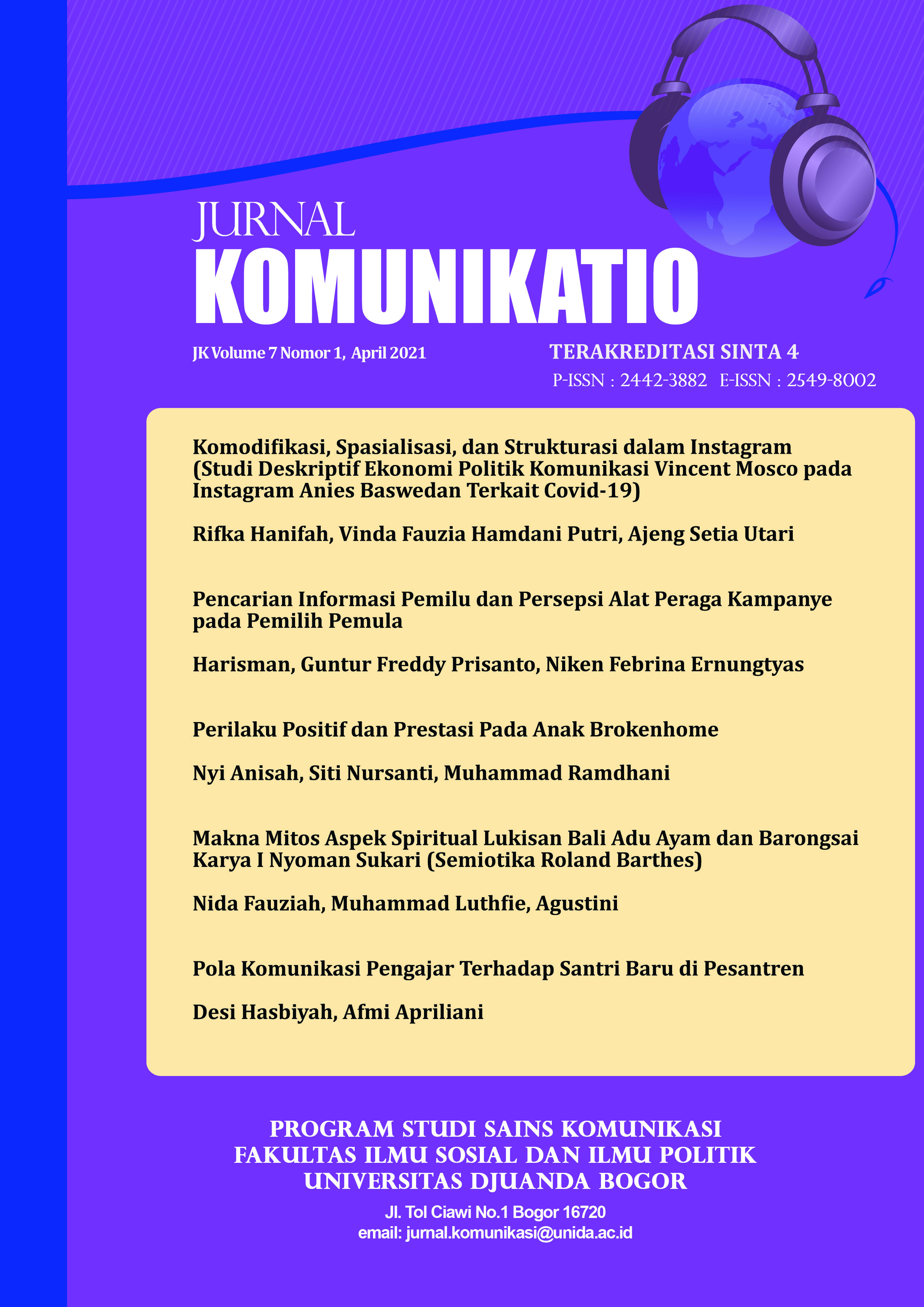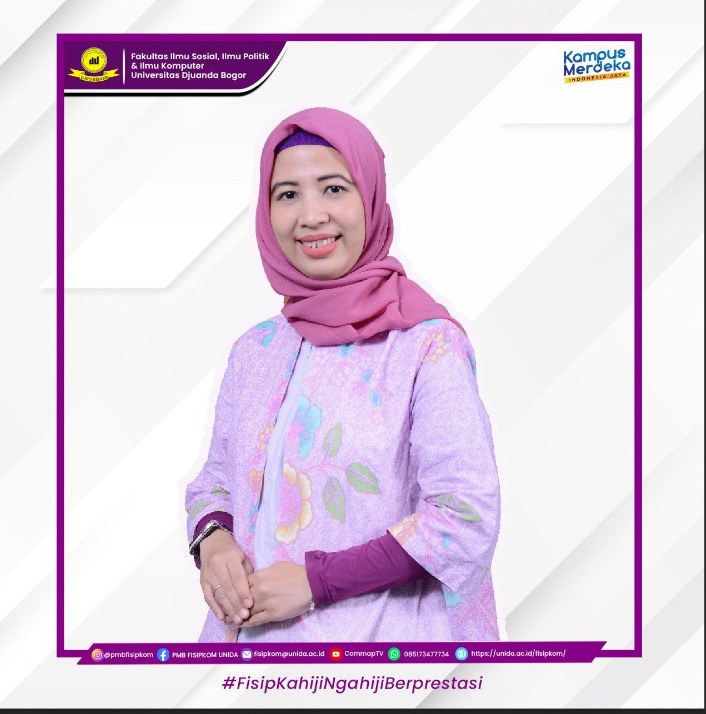ELECTION INFORMATION CAMPAIGN AND THE PERCEPTION OF CAMPAIGN PROPS IN THE BEGINNER ELECTION
DOI:
https://doi.org/10.30997/jk.v7i1.4231Keywords:
election, campaign props, information search, social mediaAbstract
The 2019 simultaneous general election formed discourse in society with massive information seeking, rapid information dissemination and discussions related to the general election. Before the election starts, every candidate has the opportunity to campaign. The campaign is an opportunity that is always given to pairs of presidential and legislative candidates. This study aims to describe the search for information about elections by first-time voters and their perceptions regarding campaign props. This study uses a qualitative approach using a case study strategy. The data collection technique used in-depth interviews with four first-time voters who live in Depok, West Java. Based on the results of coding and thematic analysis that has been carried out, there are four main themes that have emerged regarding the search for election information among first-time voters. The four main themes are political engagement, banners as campaign props, social media and information seeking. This study concludes that early voters use social media and campaign props as information source for the election decision.References
Adeodatur Latu Batara, P., Prisanto, G. F., Ernungtyas, N. F., Irwansyah, I., & Hasna, S. (2020). Strategi Komunikasi Pemasaran Politik pada Pemilu Legislatif. MetaCommunication: Journal of Communication Studies, 5(2), 184–194.
Adinugroho, B., Prisanto, G. F., Irwansyah, I., & Ernungtyas, N. F. (2019). Media Sosial dan Internet Dalam Keterlibatan Informasi Politik dan Pemilihan Umum. Jurnal Representamen, 5(02), 80–95.
https://doi.org/https://doi.org/10.30996/representamen.v5i02.2943
Afriadi, A., Prisanto, G. F., Ernungtyas, N. F., Irwansyah, I., & Afriani, A. L. (2019). Komunikasi Politik “RASA” Ala Jokowi Dalam Merespon Politik Sentimen. WACANA, 18(2), 142–153.
Ahmad, A. A., Cangara, H., & Hasrullah, H. (2017). Pembatasan Kampanye dan Rendahnya Partisipasi Pemilih pada Pilkada Serentak 2015 di Tiga Kabupaten di Sulawesi Selatan Sulawesi. Jurnal Komunikasi KAREBA, 6(1), 63–71.
Anam, C. (2018). Pengaturan Alat Peraga Kampanye Dalam Pelaksanaan Pemilihan Kepala Daerah. JKMP (Jurnal Kebijakan Dan Manajemen Publik), 6(2), 113–118. https://doi.org/10.21070/jkmp.v6i2.3005
Aprillia, H., & Baitullah, B. (2019). Persuasif pada Spanduk Pilkada di Kabupaten Merangin Tagun 2017-2018. Jurnal Tunas Pendidikan, 2(1), 82–91. http://ejournal.stkip-mmb.ac.id/index.php/pgsd/login
Arendt, F., & Fawzi, N. (2019). Googling for Trump: investigating online information seeking during the 2016 US presidential election. Information Communication and Society, 22(13), 1945–1955.
https://doi.org/10.1080/1369118X.2018.1473459
Bryman, A. (2012). Social Research Methods (4th ed.). Oxford University Press. https://doi.org/10.1192/bjp.112.483.211-a
Falimu, F. (2018). Pengaruh Alat Peraga Kampanye Terhadap Pemilih Pemula Siswa. Jurnal Sosio Sains, 4(2), 87–99.
Kavanaugh, A. L., Sheetz, S. D., Sandoval-Almazan, R., Tedesco, J. C., & Fox, E. A. (2014). Media use during conflicts: Information seeking gratifications & efficacy during 2012 Mexican elections. ACM International Conference Proceeding Series, 205–214. https://doi.org/10.1145/2612733.2612738
Muna, C., Prisanto, G. F., Ernungtyas, N. F., Irwansyah, I., & Putri, S. A. (2019). Empati dan Homofili dalam Komunikasi Politik Pemenangan Pemilihan Legislatif. Jurnal Scriptura, 9(2), 82–90. https://doi.org/10.9744/scriptura.9.2.82-90
Nasution, B., & Rimayanti, N. (2019). Perilaku Pencarian Informasi Pemilihan Umum Tahun 2019 Pemilih Pemula di Kota Pekanbaru. Jurnal Komunikatif, 8(2), 191–204.
Rahman, M. A. (2015). Kebiasaan Pencarian Informasi Murid Sekolah Menegah Atas pada Pemilu Umum di Indonesia. Record and Library Journal, 1(2), 150–160.
Rohmiyati, Y. (2018). Model Perilaku Pencarian Informasi Generasi Milenial. ANUVA, 2(4), 387–392.
Shelyana, S., & Prasetyawan, Y. Y. (2019). Pengalaman Informasi Remaja Terhadap Alat Peraga Kampanye Pemilu 2019 di Kota Semarang. Jurnal Ilmu Perpustakaan, 8(4), 1–10.
Yulyana, E. (2017). Keterlibatan Politik Perempuan dalam Proses Legislasi DPRD Kabupaten Karawang Periode 2009-2014. Jurnal Politikom Indonesiana, 2(2), 105–113.
Adinugroho, B., Prisanto, G. F., Irwansyah, I., & Ernungtyas, N. F. (2019). Media Sosial dan Internet Dalam Keterlibatan Informasi Politik dan Pemilihan Umum. Jurnal Representamen, 5(02), 80–95.
https://doi.org/https://doi.org/10.30996/representamen.v5i02.2943
Afriadi, A., Prisanto, G. F., Ernungtyas, N. F., Irwansyah, I., & Afriani, A. L. (2019). Komunikasi Politik “RASA” Ala Jokowi Dalam Merespon Politik Sentimen. WACANA, 18(2), 142–153.
Ahmad, A. A., Cangara, H., & Hasrullah, H. (2017). Pembatasan Kampanye dan Rendahnya Partisipasi Pemilih pada Pilkada Serentak 2015 di Tiga Kabupaten di Sulawesi Selatan Sulawesi. Jurnal Komunikasi KAREBA, 6(1), 63–71.
Anam, C. (2018). Pengaturan Alat Peraga Kampanye Dalam Pelaksanaan Pemilihan Kepala Daerah. JKMP (Jurnal Kebijakan Dan Manajemen Publik), 6(2), 113–118. https://doi.org/10.21070/jkmp.v6i2.3005
Aprillia, H., & Baitullah, B. (2019). Persuasif pada Spanduk Pilkada di Kabupaten Merangin Tagun 2017-2018. Jurnal Tunas Pendidikan, 2(1), 82–91. http://ejournal.stkip-mmb.ac.id/index.php/pgsd/login
Arendt, F., & Fawzi, N. (2019). Googling for Trump: investigating online information seeking during the 2016 US presidential election. Information Communication and Society, 22(13), 1945–1955.
https://doi.org/10.1080/1369118X.2018.1473459
Bryman, A. (2012). Social Research Methods (4th ed.). Oxford University Press. https://doi.org/10.1192/bjp.112.483.211-a
Falimu, F. (2018). Pengaruh Alat Peraga Kampanye Terhadap Pemilih Pemula Siswa. Jurnal Sosio Sains, 4(2), 87–99.
Kavanaugh, A. L., Sheetz, S. D., Sandoval-Almazan, R., Tedesco, J. C., & Fox, E. A. (2014). Media use during conflicts: Information seeking gratifications & efficacy during 2012 Mexican elections. ACM International Conference Proceeding Series, 205–214. https://doi.org/10.1145/2612733.2612738
Muna, C., Prisanto, G. F., Ernungtyas, N. F., Irwansyah, I., & Putri, S. A. (2019). Empati dan Homofili dalam Komunikasi Politik Pemenangan Pemilihan Legislatif. Jurnal Scriptura, 9(2), 82–90. https://doi.org/10.9744/scriptura.9.2.82-90
Nasution, B., & Rimayanti, N. (2019). Perilaku Pencarian Informasi Pemilihan Umum Tahun 2019 Pemilih Pemula di Kota Pekanbaru. Jurnal Komunikatif, 8(2), 191–204.
Rahman, M. A. (2015). Kebiasaan Pencarian Informasi Murid Sekolah Menegah Atas pada Pemilu Umum di Indonesia. Record and Library Journal, 1(2), 150–160.
Rohmiyati, Y. (2018). Model Perilaku Pencarian Informasi Generasi Milenial. ANUVA, 2(4), 387–392.
Shelyana, S., & Prasetyawan, Y. Y. (2019). Pengalaman Informasi Remaja Terhadap Alat Peraga Kampanye Pemilu 2019 di Kota Semarang. Jurnal Ilmu Perpustakaan, 8(4), 1–10.
Yulyana, E. (2017). Keterlibatan Politik Perempuan dalam Proses Legislasi DPRD Kabupaten Karawang Periode 2009-2014. Jurnal Politikom Indonesiana, 2(2), 105–113.
Downloads
Published
2021-04-21
How to Cite
Harisman, H., Prisanto, G. F., & Ernungtyas, N. F. (2021). ELECTION INFORMATION CAMPAIGN AND THE PERCEPTION OF CAMPAIGN PROPS IN THE BEGINNER ELECTION. JURNAL KOMUNIKATIO, 7(1). https://doi.org/10.30997/jk.v7i1.4231
Issue
Section
Articles
License
Authors who publish with Jurnal Komunikatio agree to the following terms:
- Authors retain copyright and grant the journal right of first publication with the work simultaneously licensed under a Creative Commons Attribution 4.0 International License that allows others to share the work with an acknowledgement of the work's authorship and initial publication in Jurnal Komunikatio.
- Authors are able to enter into separate, additional contractual arrangements for the non-exclusive distribution of the journal's published version of the work (e.g., post it to an institutional repository or publish it in a book), with an acknowledgement of its initial publication in Jurnal Komunikatio.
- Authors are permitted and encouraged to post their work online (e.g., in institutional repositories or on their website) prior to and during the submission process, as it can lead to productive exchanges, as well as earlier and greater citation of published work











